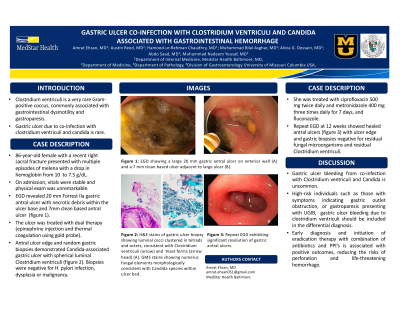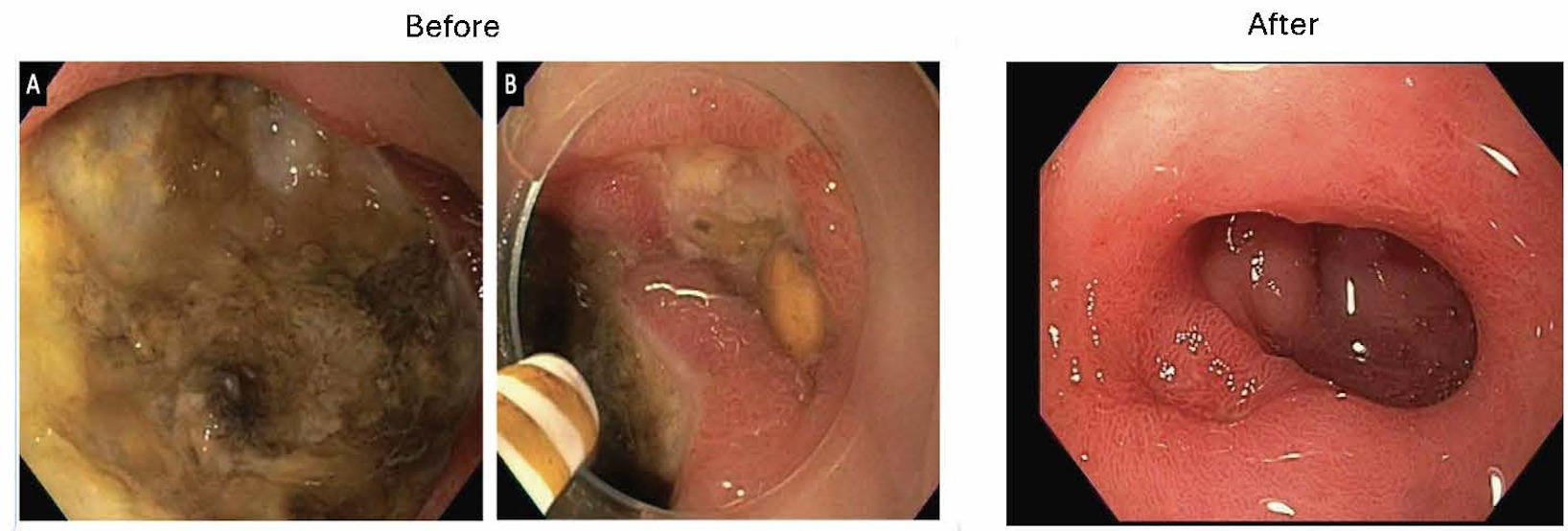Tuesday Poster Session
Category: Stomach
P5113 - Gastric Ulcer Co-Infection With Clostridium Ventriculi and Candida Associated With Gastrointestinal Hemorrhage
Tuesday, October 29, 2024
10:30 AM - 4:00 PM ET
Location: Exhibit Hall E

Has Audio
- AE
Amrat Ehsan, MBBS
MedStar Health
Baltimore, MD
Presenting Author(s)
Amrat Ehsan, MBBS1, Austin Reed, MD2, Hamood Chaudhry, MBBS3, Muhammad Asghar, MBBS1, Alicia Dessain, MD2, Abdo Saad, MD4, Muhammad Nadeem. Yousaf, MD5
1MedStar Health, Baltimore, MD; 2University of Missouri, Columbia, MO; 3University of Florida, Tampa, FL; 4American University of Beirut, Columbia, MO; 5University of Missouri Health Care, Columbia, MO
Introduction:
Clostridium ventriculi is a very rare Gram-positive coccus that is commonly associated with gastrointestinal dysmotility and gastroparesis. Gastric ulcer due to co-infection with clostridium ventriculi and candida is an extremely rare phenomenon.
Case Description/Methods: Case Discussion
An 86-year-old female with a recent right sacral fracture around two weeks prior that was being treated with high-dose NSAIDs, presented with multiple episodes of melena with a drop in hemoglobin from 10 to 7.5 g/dL. On admission, vitals were stable hemodynamics with unremarkable physical exam. A high-dose proton pump inhibitor (PPI) therapy was started. An EGD revealed 20 mm Forrest IIa gastric antral ulcer with deformed pylorus due to ulcer-associated stricture. There was necrotic debris within the ulcer base and a visible vessel with a stigmata of UGIB (figure). The ulcer was treated with dual therapy including diluted epinephrine injection and thermal coagulation using gold probe. Another 7 mm clean-based ulcer without active bleeding was identified adjacent to this gastric antral ulcer. Antral ulcer edge and random gastric biopsies were obtained. The ulcer edge and gastric biopsies demonstrated Candida-associated gastric ulcer with spherical luminal microorganisms clustered in tetrads or octets, consistent with Clostridium ventriculi. There was no evidence of Helicobacter pylori (H. pylori) infection, dysplasia or malignancy. She was treated with ciprofloxacin 500 mg twice daily and metronidazole 400 mg three times daily for 7 days, and fluconazole. Repeat EGD at 12 weeks showed healing antral ulcers with ulcer edge and gastric biopsies showed only mild reactive gastropathy with adjacent fibrinous exudate, suggestive of mild erosion in the context of a healing ulcer. Grocott methenamine special stains (GMS) and Periodic acid Schiff (PAS) stain were negative for residual fungal microorganisms and residual Clostridium ventriculi.
Discussion: Discussion
Gastric ulcer bleeding from co-infection with Clostridium ventriculi and Candida is uncommon. However, in high-risk individuals such as those with symptoms indicating gastric outlet obstruction, or gastroparesis presenting with UGIB, and gastric ulcer bleeding due to clostridium ventriculi should be included in the differential diagnosis. Early diagnosis and initiation of eradication therapy with combination of antibiotics and PPI’s is associated with positive outcomes, reducing the risks of perforation and life-threatening hemorrhage.

Disclosures:
Amrat Ehsan, MBBS1, Austin Reed, MD2, Hamood Chaudhry, MBBS3, Muhammad Asghar, MBBS1, Alicia Dessain, MD2, Abdo Saad, MD4, Muhammad Nadeem. Yousaf, MD5. P5113 - Gastric Ulcer Co-Infection With Clostridium Ventriculi and Candida Associated With Gastrointestinal Hemorrhage, ACG 2024 Annual Scientific Meeting Abstracts. Philadelphia, PA: American College of Gastroenterology.
1MedStar Health, Baltimore, MD; 2University of Missouri, Columbia, MO; 3University of Florida, Tampa, FL; 4American University of Beirut, Columbia, MO; 5University of Missouri Health Care, Columbia, MO
Introduction:
Clostridium ventriculi is a very rare Gram-positive coccus that is commonly associated with gastrointestinal dysmotility and gastroparesis. Gastric ulcer due to co-infection with clostridium ventriculi and candida is an extremely rare phenomenon.
Case Description/Methods: Case Discussion
An 86-year-old female with a recent right sacral fracture around two weeks prior that was being treated with high-dose NSAIDs, presented with multiple episodes of melena with a drop in hemoglobin from 10 to 7.5 g/dL. On admission, vitals were stable hemodynamics with unremarkable physical exam. A high-dose proton pump inhibitor (PPI) therapy was started. An EGD revealed 20 mm Forrest IIa gastric antral ulcer with deformed pylorus due to ulcer-associated stricture. There was necrotic debris within the ulcer base and a visible vessel with a stigmata of UGIB (figure). The ulcer was treated with dual therapy including diluted epinephrine injection and thermal coagulation using gold probe. Another 7 mm clean-based ulcer without active bleeding was identified adjacent to this gastric antral ulcer. Antral ulcer edge and random gastric biopsies were obtained. The ulcer edge and gastric biopsies demonstrated Candida-associated gastric ulcer with spherical luminal microorganisms clustered in tetrads or octets, consistent with Clostridium ventriculi. There was no evidence of Helicobacter pylori (H. pylori) infection, dysplasia or malignancy. She was treated with ciprofloxacin 500 mg twice daily and metronidazole 400 mg three times daily for 7 days, and fluconazole. Repeat EGD at 12 weeks showed healing antral ulcers with ulcer edge and gastric biopsies showed only mild reactive gastropathy with adjacent fibrinous exudate, suggestive of mild erosion in the context of a healing ulcer. Grocott methenamine special stains (GMS) and Periodic acid Schiff (PAS) stain were negative for residual fungal microorganisms and residual Clostridium ventriculi.
Discussion: Discussion
Gastric ulcer bleeding from co-infection with Clostridium ventriculi and Candida is uncommon. However, in high-risk individuals such as those with symptoms indicating gastric outlet obstruction, or gastroparesis presenting with UGIB, and gastric ulcer bleeding due to clostridium ventriculi should be included in the differential diagnosis. Early diagnosis and initiation of eradication therapy with combination of antibiotics and PPI’s is associated with positive outcomes, reducing the risks of perforation and life-threatening hemorrhage.

Figure: Before (A, B) and after treatment
Disclosures:
Amrat Ehsan indicated no relevant financial relationships.
Austin Reed indicated no relevant financial relationships.
Hamood Chaudhry indicated no relevant financial relationships.
Muhammad Asghar indicated no relevant financial relationships.
Alicia Dessain indicated no relevant financial relationships.
Abdo Saad indicated no relevant financial relationships.
Muhammad Yousaf indicated no relevant financial relationships.
Amrat Ehsan, MBBS1, Austin Reed, MD2, Hamood Chaudhry, MBBS3, Muhammad Asghar, MBBS1, Alicia Dessain, MD2, Abdo Saad, MD4, Muhammad Nadeem. Yousaf, MD5. P5113 - Gastric Ulcer Co-Infection With Clostridium Ventriculi and Candida Associated With Gastrointestinal Hemorrhage, ACG 2024 Annual Scientific Meeting Abstracts. Philadelphia, PA: American College of Gastroenterology.
